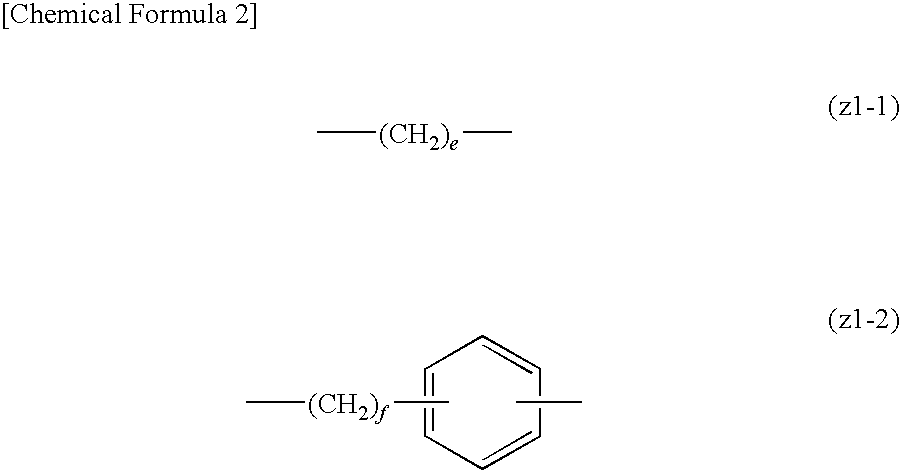Positive resist composition and method of forming resist pattern
a technology of positive resist and composition, applied in the field of positive resist composition, can solve the problems of reducing the pattern dimensions, affecting the formation of very fine semiconductor elements, and affecting the degree of fineness of semiconductor elements, so as to reduce the roughness level
- Summary
- Abstract
- Description
- Claims
- Application Information
AI Technical Summary
Benefits of technology
Problems solved by technology
Method used
Image
Examples
synthesis example 1
Synthesis of 2,2-bis{4,4-bis(4-hydroxy-3-hydroxymethyl-5-methylphenyl)cyclohexyl}propane
[0452]A 5 L four-necked flask was charged with 1,020.0 g (4.08 mol) of a 16% by weight aqueous solution of sodium hydroxide, and this reaction vessel was purged with nitrogen. Thereafter, 538.0 g (0.85 mol) of 2,2-bis{4,4-bis(4-hydroxy-5-methylphenyl)cyclohexyl}propane was further added thereto at a temperature of about 35° C., and the resulting mixture was then stirred for 1 hour. 947.1 g (11.05 mol) of a 35% by weight aqueous formaldehyde solution was then added to the mixture while stirring at 25 to 30° C. over a period of 2 hours to effect a reaction. Thereafter, a reaction was performed with stirring at 30° C. for a further 5 hours.
[0453]Following completion of the reaction, the reaction solution was cooled to 10° C., and 550.8 g of methyl ethyl ketone was added dropwise thereto over a period of 20 minutes, followed by the addition of 1280.0 g of methyl isobutyl ketone. Subsequently, the rea...
synthesis example 2
Synthesis of 2,2-bis{4,4-bis(3-formyl-4-hydroxy-5-methylphenyl)cyclohexyl}propane
[0455]A 3 L four-necked flask was charged with 461.7 g (4.05 mol) of trifluoroacetic acid, and this reaction vessel was purged with nitrogen. Thereafter, 83.3 g (0.594 mol) of hexamethylenetetramine was added to the reaction system at a temperature of about 30° C., and then 101.7 g (0.135 mol) of the 2,2-bis{4,4-bis(4-hydroxy-3-hydroxymethyl-5-methylphenyl)cyclohexyl}propane (in a methylol form) obtained in Synthesis Example 1 was further added to the resulting mixture while stirring at 60° C. over a period of 1.5 hours to effect a reaction. Thereafter, a reaction was performed with stirring at 80° C. for a further 16 hours.
[0456]Following completion of the reaction, 251.5 g of water was added to the obtained reaction solution, and a hydrolysis reaction was performed at 60° C. for 1 hour. A viscous solid material precipitated during the hydrolysis. 201.2 g of toluene and 301.8 g of methyl isobutyl keton...
synthesis example 3
Synthesis of 2,2-bis{4,4-bis(3-formyl-4-methoxycarbonylmethoxy-5-methylphenyl)cyclohexyl}propane
[0461]A 500 mL four-necked flask was charged with 37.2 g (0.05 mol) of the 2,2-bis{4,4-bis(3-formyl-4-hydroxy-5-methylphenyl)cyclohexyl}propane obtained in Synthesis Example 2 and 111.6 g of N-methylpyrrolidone, and the inside of this flask was purged with nitrogen. After heating this mixture solution to 50° C., 5.6 g (0.034 mol) of potassium iodide and 33.1 g (0.24 mol) of potassium carbonate were further added thereto, and the resulting mixture was then stirred for 1 hour. Subsequently, the resulting mixture was then heated to 60° C., and 64.8 g (0.60 mol) of methyl chloroacetate was then added dropwise to the mixture while stirring over a period of 1 hour to effect a reaction. Thereafter, the reaction was continued with stirring at 60° C. for a further 3 hours.
[0462]Following completion of the reaction, 98.0 g of methyl isobutyl ketone and 147.0 g of water were added to the obtained re...
PUM
| Property | Measurement | Unit |
|---|---|---|
| temperature | aaaaa | aaaaa |
| temperature | aaaaa | aaaaa |
| temperature | aaaaa | aaaaa |
Abstract
Description
Claims
Application Information
 Login to View More
Login to View More - R&D
- Intellectual Property
- Life Sciences
- Materials
- Tech Scout
- Unparalleled Data Quality
- Higher Quality Content
- 60% Fewer Hallucinations
Browse by: Latest US Patents, China's latest patents, Technical Efficacy Thesaurus, Application Domain, Technology Topic, Popular Technical Reports.
© 2025 PatSnap. All rights reserved.Legal|Privacy policy|Modern Slavery Act Transparency Statement|Sitemap|About US| Contact US: help@patsnap.com



